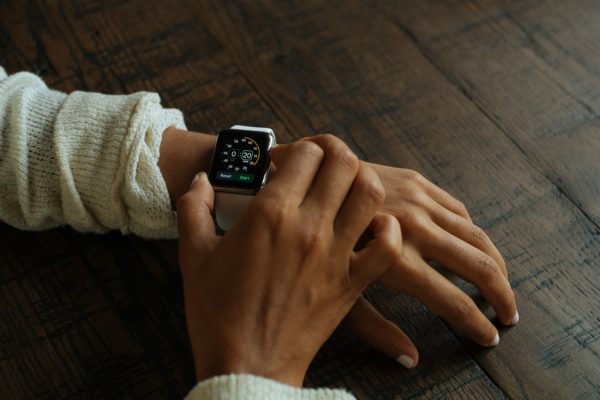A product that addresses the leading cause of death for men and women in the United States – heart disease. Learn how we helped our client design and create the architecture that processes thousands of patients’ data in real-time.
About the product
Empeek was tasked to develop a mobile cardiac telemetry system that consists of an ECG patch and mobile app.
The system is designed to scale to thousands of patients at once and help both doctors and patients avert life-threatening events.
The company was founded in 2013 and is a leader among mid-sized mobile cardiac telemetry services providers in the US.
Industry: Healthcare
Location: USA

Real-time monitoring of cardiac health indicators for thousands of patients simultaneously
Target Market
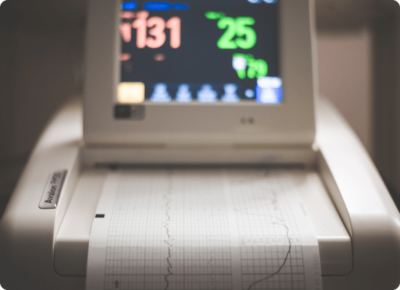
Our client addresses the leading cause of death for men and women in the United States – heart disease.
Fewer than 7% of all American adults have optimal health across five central heart and metabolic health areas, including cardiovascular disease status.
Even more staggering is the fact that 1 in 5 heart attacks are silent, causing patients no immediate alarm despite still causing damage and posing severe life-threatening challenges. The company’s market size comprises roughly 20.1 million adults aged 20 and older that have CAD (about 7.2%).
Goals
We had less than a year to create a new telemetry solution that would
track the heart rate data of thousands of patients. Our priorities were as follows:
Design an architecture that could scale and track the heart indicators in real time
Cloud Portal for multiple users
BadBeats Integration
Android Mobile Application
The Story Behind the ECG Monitoring System Project
Every change starts from the need to become better. Before deciding to begin development, the customer used a third-party patient monitoring service and a third-party patch. It offered limited functionality and could not be scaled by the healthcare provider.
After considering all pros and cons, the company decided to design its own cloud-based solution that would consist of Web and Mobile applications.
About the Product
- This cardiac telemetry system sends real-time cardiac data to the company’s cardiac experts, who monitor and identify abnormalities 24 hours a day, 7 days a week;
- Once the data is analyzed, the results are then sent to the doctors for review;
- Both patients and doctors can see how the indications change over the day to track the dynamics and make more data-driven decisions;


- The patient doesn’t have permission to make any alteration to the data. However, there is a Diary option, where the patient can leave essential notes of their activities;
- The ECG device is compact and mobile, allowing patients to be monitored from the comfort of their home, which decreases the total cost of the care for the insurer, clinic and patient;
- The algorithm automatically filters data to highlight patients that present high-risk abnormalities. It also automatically categorizes abnormalities by their risk level, alerting technicians reading cardiograms of who might need urgent help;
- Since the system is highly customizable, healthcare organizations can set up several categories of patients to configure data collection. The standard heart rates of athletes and children differ, for example, so it’s essential to take this into account.

How It All Started
From the beginning, we understood that we needed to see beyond the “fitness tracker mode.”
Empeek started from the Discovery phase to evaluate the scope and create a software development plan.
Team Involved in the Discovery
On Empeek’s side
- Analyst/Project Manager
- CTO
- System Architect
On Client’s side
- Designer
- Hardware developers
- Algorithm developers
- FDA consultant
20.1 million adults aged 20 and older that have Coronary artery disease (CAD)
We Developed Web Application’s Cloud Portals
Portal for Data Management
Interface for company’s cardiac specialist, and physicians with different levels of access to patients’ data. The core task of cardiac specialists is to review the monitored data, check suggested alarms by the system, finalize the report and send it to physicians.
From the physicians’ point of view, they are able to create and add new patients, review all raw data of each patient, including a diary, and form their own reports for patients.

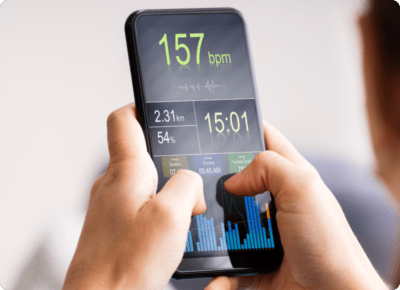
Mobile UI for a User
Each patient has access to the mobile app and can review each health indicator being tracked. They can’t alter the data but can add notes of their day-to-day activities.
Android application
The Android application provides a connection between the ECG Patch and Cloud Server, using Bluetooth between Patch and Phone via BLE protocol, and Cellular / Wi-Fi connection between Phone and Server via HTTPS protocol.
The application provides additional features such as:
- Transferring and displaying the data gathered from the Patch device
- Ability to report symptoms by patient
- Ability to watch tutorials of the device usage
- Ability to automatically check for, download and install newer software and firmware updates as well as new tutorials and updated symptoms lists
- Display the patient’s symptoms, with the ability to send them to the Cloud Server (the list is updated from the Cloud Server)
- Automatically enter energy saving mode (turn off the display, but keep Wi-Fi and Bluetooth running)
- Work as interim layer for Patch firmware updates, remote command executions, with the ability to update its own version without requesting permissions (adb-mode)
- OTA updates.

Core Health Indicators
The device tracks 5 health parameters:
ECG Heart rate SPO2 Temperature Activity level
Empeek consulted with FDA experts since the product would be certified for FDA and HIPAA compliant
How the Wearable ECG Monitoring Device Operates
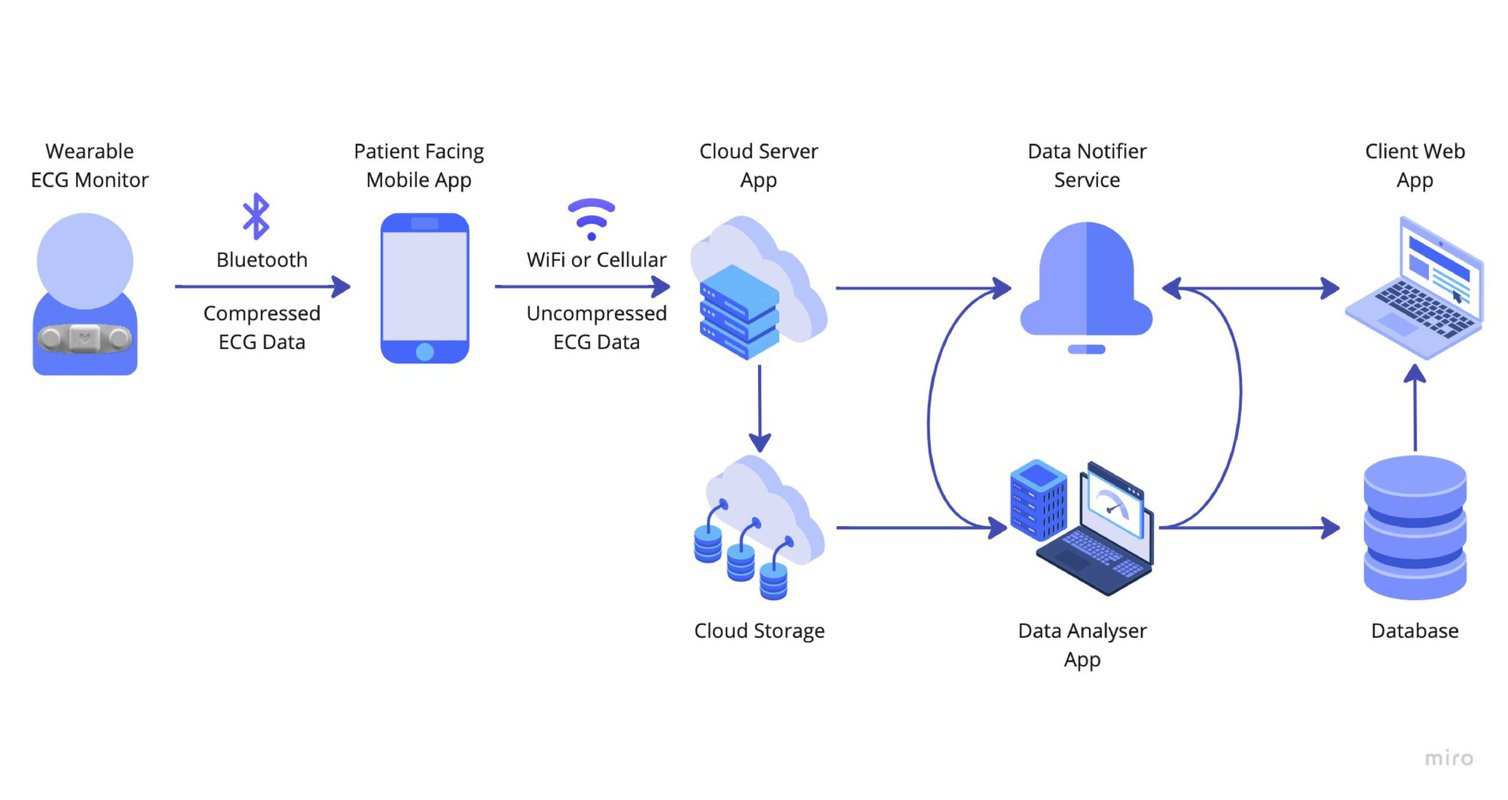
The developed mobile cardiac telemetry device is based on a portable electrocardiogram (ECG) sensor. It’s small and convenient enough to wear throughout the day underneath clothing. The sensor has a battery, Bluetooth and electrodes placed at specific points on the abdomen and chest. It records the minimum and maximum electrical activity of the heart in numbers.
Afterward, the algorithm converts the recorded data to a cardiogram that healthcare workers can further process. A team of technicians can receive dozens or even hundreds of cardiograms with highlighted abnormalities, allowing them to quickly detect any problems and validate the generated cardiograms, therefore saving precious time.
The mobile application supplied as a part of the solution is responsible for collecting, filtering and uploading raw sensor data. It also enables patients to track their heart activity and share information about their well-being to provide healthcare professionals with additional details.
The cardiac telemetry device collects data on up to twenty cardiac health indicators, including:
- Atrial fibrillation;
- sinus rhythm;
- sinus bradycardia;
- sinus tachycardia;
- junctional tachycardia;
- pauses.
Combining these data types helps in tracking cardiac health and detecting abnormalities.
Vital Activity Widget
For comprehensive data review, Empeek developed a Vital Activity widget. It shows the user’s main vital data on a custom-set timeline. It can be any timeframe like 4 hours, two weeks or a month. The color-coded scale displays temperature, activity, saturation and respiratory rate in a collapsed form.
End-to-End Software Development Team Composition

Empeek comprised a team of about twenty software development professionals to boost development. It included BA, PMs, UX Designers, Front-End and Back-End Developers, Software Architects, DevOps andTesters.
Once we developed the base of the product, the final team consisted of:
- Five Software Developers
- 2 QA Testers
- 1 PM
- 1 BA
After the release, our DevOps were accessible 24/7 to secure the flawless operation of the system.
Core Challenge
To develop a system that can process and transmit large amounts of data in real time,
taking into consideration the continued growth and scale of the application.
Technology Stack
- .NET
- React
- React Native
- AWS
- Kafka
- Amazon S3
- MongoDB
- PostgreSQL
Services Provided
- Front-End
- Back-End
- UX Design
- Testing
- Maintenance
- Subject-matter Consultation – FDA Compliance and Application
- Project Management
- Business Analyst
After the release, our DevOps were accessible 24/7 to secure the flawless operation of the system.
The Development Phase
The Project was developed using Agile methodology, Scrum-based planning and management processes, GIT flow for development, CI/CD (Continuous Integration/Continuous Delivery) delivery model, mixed QA processes (manual and automated) and performance and load testing. The project development was supported by code review, quality control and hardware integration experts in the team.
During the software design process, we had some constraints. The global microchip manufacturing shortage and COVID lockdown postponed the development and release of the client’s own patch, and therefore, the software itself.
Empeek consulted with FDA experts since the product would be certified for FDA and HIPAA compliance.

The Results
The application demonstrates stable performance and successfully processes real-time cardiac data.
Fully Working Web Application
We developed a fully working web application so our client’s business could continue its operations.
Android App
A mobile application that works with a patch and transmits data to the web app.
Cloud Architecture
A system that processes real-time data from thousands of patients and can be scaled.
The Last, but not Least… Next Steps
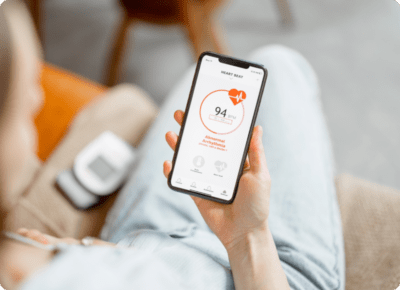
Research the possibility of creating a neural network for a better learning experience of the ECG monitoring system.
At the moment, our client uses a third-party BadBeats detection solution. The company decided to take on the entire system to reduce risk and improve results.
FAQs
What are the elements of the mobile cardiac telemetry device?
The ECG monitoring system consists of three core components:
- A wearable patch that is placed upon the chest of the patient;
- A mobile application accessible only via a unique access link;
A web application which allows technicians, doctors and patients to monitor and track data.
What methodology did you use to build the remote heart rate monitoring system?
To meet the client’s requirements, we used Agile Software Development.
How much time did it take to build the remote cardiac monitoring system?
It took us about a year to develop fully-functional software for the remote cardiac monitoring system. Some external factors postponed development. However, the team met the deadline and delivered a solution with stable performance.
What were the stages involved in the development of the ECG monitoring system software?
Empeek started with a Discovery Phase service. Once finished, we started with Agile software development with bi-weekly sprints. The next step was software testing and performance improvements.
We also had close communication with an FDA Consultant to meet the requirements for certification.
What are the core heart indicators that mobile cardiac telemetry device track?
The mobile cardiac telemetry device tracks up to twenty heart parameters, such as:
- sinus rhythm
- sinus bradycardia
- sinus tachycardia
- junctional tachycardia
- pauses
and other critical types of heart activity.
How was the development team comprised?
There is no single answer to this question. Depending on the development stage and requirements, Empeek quickly scaled and downscaled the team.
In the final stage of the development, the team comprised:
- Five Software Developers;
- 2 QA Testers;
- 1 PM;
- 1 BA;
- 2 DevOps to secure the system.

![Remote Patient Monitoring Software [Case Study]](https://empeek.com/wp-content/uploads/2024/09/rpm-10-k-users.jpg)
